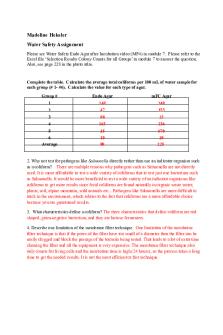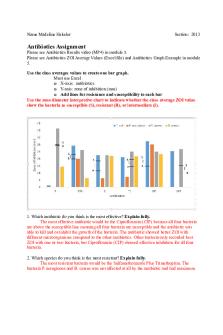bio 245 Lab 11 worksheet PDF

| Title | bio 245 Lab 11 worksheet |
|---|---|
| Author | Maddy Hekeler |
| Course | General Microbiology (2, 4) |
| Institution | James Madison University |
| Pages | 2 |
| File Size | 89 KB |
| File Type | |
| Total Downloads | 46 |
| Total Views | 152 |
Summary
Dr. Powers comprehensive notes...
Description
Name: Madeline Hekeler
Section: 2013
Induction and Catabolite Repression Assignment First, please read Chapter 17 Induction and Catabolite Repression and the assigned Photo Atlas pages. Then, please see the videos, Induction Results, Repression Iodine Addition and Repression Results (MP4 files) in Module 10. Complete the table as indicated using the videos. Glucose Color of solution Clear or Yellow? Beta-galactosidase present? Yes or no?
Clear
Lactose Yellow
No
Glycerol clear
Yes
no
Complete the table as indicated using the videos. Starch only Zone of clearing present? Yes or no?
Yes
Amylase present? Yes or no?
yes
Starch plus glucose no
no
1. Which substrate induced beta-galactosidase? The substrate that induced betagalactosidase was lactose.
2. What reaction produced the yellow color? Be specific. The reaction that produced the yellow color was adding the chemical indicator ONPG. Beta-galactosidase cleaves ONPG in the same way that it cleaves lactose. When ONPG is broken down, one of the products of the reaction is the yellow dye. When the yellow dye is present, that means beta-galactosidase is present.
3. What experimental results (from this exercise) would you expect if beta-galactosidase were a constitutive enzyme? Explain fully. A constitutive enzyme means that it is continuously synthesized and always produces whether or not a suitable substrate is present. If beta-galactosidase was a constitutive enzyme, then it would always be expressed whether it was in the presence or absence of lactose. Therefore, the experimental results that would be expected would be for all test tubes to turn yellow even if they contained glucose or glycerol. The ONPG would cleave the same way for all substrates and when broken down would release the color yellow.
1
4. In the catabolite repression exercise, was Bacillus able to synthesize amylase? How do you know? Explain fully. Yes, the Bacillus had a positive amylase test meaning that it was able to synthesize amylase. This was indicated by the clear zone that surrounded only the starch plate, not the starch and glucose plate, because amylase was able to digest the starch.
5. Did you observe catabolite repression when glucose was added to the starch? If so, how did you determine that? Explain fully. Yes, catabolite repression was observed when glucose was added to the starch. When the glucose is available, the cell will not break down starch because glucose represses amylases, the enzyme needed for the breakdown of starch. This was indicated by the fact that there was no clear zone around the glucose and starch plate, and the entire agar plate was purplish in color. Therefore, showing that the amylase was repressed and unable to do its job because it would have produced a clear zone if it was.
6. What experimental results (from this exercise) would you expect if amylase were a constitutive enzyme? If amylase was a constitutive enzyme it would continuously be synthesize and always be available in both the present and absence of glucose. Therefore, the experimental results would differ, and both the starch only plate and the starch and glucose plate would always have a clear zone evident.
2...
Similar Free PDFs

bio 245 Lab 11 worksheet
- 2 Pages

bio 245 Lab 8 worksheet
- 3 Pages

BIO 1101 - LAB 11
- 4 Pages

Lab 11 Respiration worksheet
- 5 Pages

Bio 1012 Lab 11 Notes
- 4 Pages

Bio 11- Lab 11- Human Genetics
- 10 Pages

Bio 11- lab 3- microscopy
- 6 Pages

BIO 101 Lab 11, Mendelian Genetics
- 12 Pages

Bio-Worksheet-Mutations
- 2 Pages

Samenvatting hppfdstuk 11 bio
- 9 Pages

Chapter 10 worksheet - bio
- 8 Pages
Popular Institutions
- Tinajero National High School - Annex
- Politeknik Caltex Riau
- Yokohama City University
- SGT University
- University of Al-Qadisiyah
- Divine Word College of Vigan
- Techniek College Rotterdam
- Universidade de Santiago
- Universiti Teknologi MARA Cawangan Johor Kampus Pasir Gudang
- Poltekkes Kemenkes Yogyakarta
- Baguio City National High School
- Colegio san marcos
- preparatoria uno
- Centro de Bachillerato Tecnológico Industrial y de Servicios No. 107
- Dalian Maritime University
- Quang Trung Secondary School
- Colegio Tecnológico en Informática
- Corporación Regional de Educación Superior
- Grupo CEDVA
- Dar Al Uloom University
- Centro de Estudios Preuniversitarios de la Universidad Nacional de Ingeniería
- 上智大学
- Aakash International School, Nuna Majara
- San Felipe Neri Catholic School
- Kang Chiao International School - New Taipei City
- Misamis Occidental National High School
- Institución Educativa Escuela Normal Juan Ladrilleros
- Kolehiyo ng Pantukan
- Batanes State College
- Instituto Continental
- Sekolah Menengah Kejuruan Kesehatan Kaltara (Tarakan)
- Colegio de La Inmaculada Concepcion - Cebu




